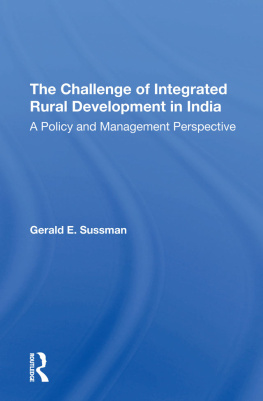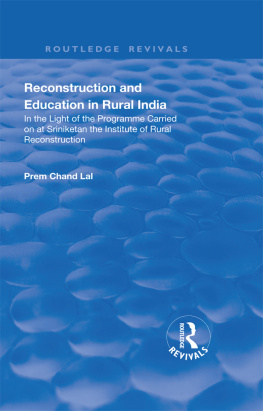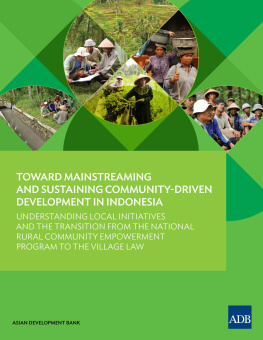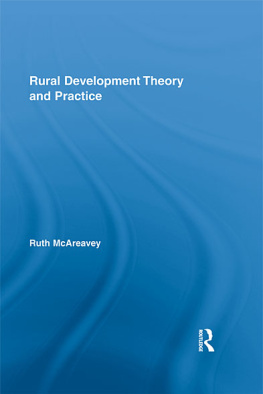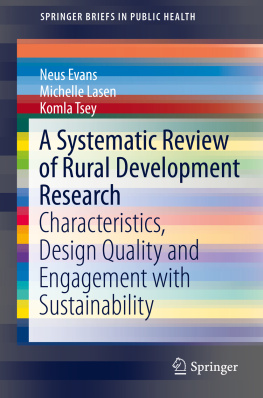The Challenge of Integrated Rural Development in India
Westview Replica Editions
The concept of Westview Replica Editions is a response to the continuing crisis in academic and informational publishing. Library budgets for books have been severely curtailed. Ever larger portions of general library budgets are being diverted from the purchase of books and used for data banks, computers, micromedia, and other methods of information retrieval. Interlibrary loan structures further reduce the edition sizes required to satisfy the needs of the scholarly community. Economic pressures (particularly inflation and high interest rates) on the university presses and the few private scholarly publishing companies have severely limited the capacity of the industry to properly serve the academic and research communities. As a result, many manuscripts dealing with important subjects, often representing the highest level of scholarship, are no longer economically viable publishing projectsor, if accepted for publication, are typically subject to lead times ranging from one to three years.
Westview Replica Editions are our practical solution to the problem. We accept a manuscript in camera-ready form, typed according to our specifications, and move it immediately into the production process. As always, the selection criteria include the importance of the subject, the work's contribution to scholarship, and its insight, originality of thought, and excellence of exposition. The responsibility for editing and proofreading lies with the author or sponsoring institution. We prepare chapter headings and display pages, file for copyright, and obtain Library of Congress Cataloging in Publication Data. A detailed manual contains simple instructions for preparing the final typescript, and our editorial staff is always available to answer questions.
The end result is a book printed on acid-free paper and bound in sturdy library-quality soft covers. We manufacture these books ourselves using equipment that does not require a lengthy make-ready process and that allows us to publish first editions of 300 to 600 copies and to reprint even smaller quantities as needed. Thus, we can produce Replica Editions quickly and can keep even very specialized books in print as long as there is a demand for them.
About the Book and Author
The Challenge of Integrated Rural Development in India: A Policy and Management Perspective
Gerald E. Sussman
In 1952, India launched a massive and enthusiastic effort to reach the 360 million people in its 550,000 villages with a national program of economic and social reconstruction. Known as Community Development, the program provided an innovative model of rural development for both Third World nations and the aid-giving countries of the West. Although the program achieved its goal of providing service coverage to the nation, its many implementation problems and the lack of quantifiable cost-effectiveness led critics to label it a failure and resulted in its submergence into the Ministry of Food and Agriculture in 1966. More recently, however, partly as a result of the social dislocations following the "Green Revolution," there has been renewed interest in Community Development as the Indian government searches for ways of effectively implementing a strategy of integrated rural development. It is recognized that a repeat of the CD program is not the answer; but an analysis of the program allows the identification of the elements critical to good administrationand political survival.
Drawing on extensive interviews with Indian and American participants, this book critically appraises the Community Development program. Dr. Sussman examines the successful pilot project at Etawah, then documents the many problemsorganizational, political, and logisticalthat were encountered in the attempt to replicate it on a nationwide scale, and that eventually led to its demise. From his analysis emerges the question of what kind of government strategies can best equip rural populations to participate in development. Admitting the difficulties still to be faced, he concludes on a note of guarded optimism based on recent efforts in both India and the U.S. that combine a systems approach with the use of a range of development strategies.
Dr. Gerald E. Sussman is presently on the teaching faculty of the School of Public Health, University of Texas Health Science Center, and is the director of the Public Health Regional Administration Program. This book is the result of many years of actual field work and research.
To all those who worked on Indian rural development and formed the substance of this research; to my wife, Roberta, who patiently worked with me on its preparation; to Dr. Richard L. Park who continually encouraged my efforts and provided the study with many of its strongest insights, and to Albert Mayer and Chester Bowies whose contributions to India's development exemplified Indo-American cooperation, this book is dedicated.
The Challenge of Integrated Rural Development in India
A Policy and Management Perspective
Gerald E. Sussman
First published 1982 by Westview Press, Inc.
Published 2019 by Routledge
52 Vanderbilt Avenue, New York, NY 10017
2 Park Square, Milton Park, Abingdon, Oxon OX14 4RN
Routledge is an imprint of the Taylor & Francis Group, an informa business
Copyright 1982 Taylor & Francis
All rights reserved. No part of this book may be reprinted or reproduced or utilised in any form or by any electronic, mechanical, or other means, now known or hereafter invented, including photocopying and recording, or in any information storage or retrieval system, without permission in writing from the publishers.
Notice:
Product or corporate names may be trademarks or registered trademarks, and are used only for identification and explanation without intent to infringe.
Library of Congress Cataloging in Publication Data
Sussman, Gerald Edward.
The challenge of integrated rural development in India.
(A Westview replica edition)
Bibliography: p.
Includes index.
1. Rural developmentIndia. 2. Agriculture and stateIndia. I. Title.
HD2072.S82 1982 338.954'009173'4 82-11009
ISBN 13: 978-0-367-29061-0 (hbk)
crore ten million
gram village
gramsevak village level worker (literally servant of the village)
harijan Gandhian term for members of the "untouchable" caste (literally "child of God")
hansiya traditional sickle
kharif summer or rainy season of agriculture, which begins with sowing in late spring and ends with autumn harvest
khurpi weeding knife
lakh one hundred thousand
maund Indian measure of weight equal to approximately 82 pounds
panchayat village council (literally "assembly of five")
parichayati raj local government by village councils established under the Panchayati Raj legislation in each of the states. A three-tier structure was generally established corresponding to the village, block and district, with powers generally concentrated at the block
pradhan president of the village council
rabi winter cropping season, beginning in autumn and ending with the spring or summer harvest
rupee primary Indian monetary unit (approximately 7.8 rupees = one dollar)

